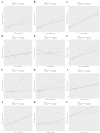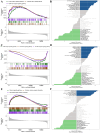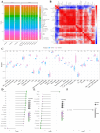From proteome to pathogenesis: investigating polycystic ovary syndrome with Mendelian randomization analysis
- PMID: 39314522
- PMCID: PMC11417002
- DOI: 10.3389/fendo.2024.1442483
From proteome to pathogenesis: investigating polycystic ovary syndrome with Mendelian randomization analysis
Abstract
Background: Polycystic ovary syndrome (PCOS) is defined by oligo/anovulation, hyperandrogenism, and polycystic ovaries with uncertain pathogenesis. The proteome represents a substantial source of therapeutic targets, and their coding genes may elucidate the mechanisms underlying PCOS. However, reports on the profiles of the human plasma protein-coding genes and PCOS are limited. Here, we aimed to investigate novel biomarkers or drug targets for PCOS by integrating genetics and the human plasma proteome.
Methods: Our study acquired the protein quantitative trait loci from DECODE Genetics, offering 4,907 proteins in 35,559 individuals while obtaining PCOS summary statistics by accessing the FinnGen biobank (1,639 cases and 218,970 controls) and the genome-wide association study catalog (797 cases and 140,558 controls). Herein, we sequentially used two-sample Mendelian randomization (MR) analyses and colocalization to verify the causal link between candidate proteins, their coding genes, and PCOS. Further PCOS data download was conducted by accessing the Gene Expression Omnibus and Zenodo platforms. Gene expression level analysis, pathway enrichment analysis, immune cell infiltration, and transcription factor prediction were performed, aiming at detecting specific cell types with enriched expression and exploring potential optimized treatments for PCOS.
Results: MR analysis revealed 243 protein-coding genes with a causal relationship to PCOS risk, of which 12 were prioritized with the most significant evidence. Through colocalization analysis, three key genes, CUB domain-containing protein 1 (CDCP1), glutaredoxin 2 (GLRX2), and kirre-like nephrin family adhesion molecule 2 (KIRREL2), were identified. Subsequently, the three genes were strongly related to immune function and metabolism in terms of biological significance. In single-cell analysis, the expression levels of genes in ovarian theca cells were explored.
Conclusion: Overall, three protein-coding genes (CDCP1, GLRX2, and KIRREL2) may be related to a higher PCOS risk, suggesting that they may be entry points for exploration of PCOS pathogenesis and treatment, warranting further clinical investigations.
Keywords: Mendelian randomization; bioinformatics; metabolism; polycystic ovary syndrome; proteome.
Copyright © 2024 Zhang, Li, Gong and Wang.
Conflict of interest statement
The authors declare that the research was conducted in the absence of any commercial or financial relationships that could be construed as a potential conflict of interest.
Figures










Similar articles
-
Proteome-wide Mendelian randomization and functional studies uncover therapeutic targets for polycystic ovarian syndrome.Am J Hum Genet. 2024 Dec 5;111(12):2799-2813. doi: 10.1016/j.ajhg.2024.10.008. Epub 2024 Nov 13. Am J Hum Genet. 2024. PMID: 39541979 Free PMC article.
-
Proteome-Wide Mendelian Randomization Identifies Therapeutic Targets for Abdominal Aortic Aneurysm.J Am Heart Assoc. 2025 Feb 4;14(3):e038193. doi: 10.1161/JAHA.124.038193. Epub 2025 Feb 3. J Am Heart Assoc. 2025. PMID: 39895541 Free PMC article.
-
Plasma cytokine levels and PCOS risk: Mendelian randomization analysis reveals IL6R as a preventive factor.J Ovarian Res. 2025 Apr 3;18(1):69. doi: 10.1186/s13048-025-01647-w. J Ovarian Res. 2025. PMID: 40181376 Free PMC article.
-
Causal relationship between gut microbiota and polycystic ovary syndrome: a literature review and Mendelian randomization study.Front Endocrinol (Lausanne). 2024 Feb 1;15:1280983. doi: 10.3389/fendo.2024.1280983. eCollection 2024. Front Endocrinol (Lausanne). 2024. PMID: 38362275 Free PMC article. Review.
-
Causes and Consequences of Polycystic Ovary Syndrome: Insights From Mendelian Randomization.J Clin Endocrinol Metab. 2022 Feb 17;107(3):e899-e911. doi: 10.1210/clinem/dgab757. J Clin Endocrinol Metab. 2022. PMID: 34669940 Free PMC article. Review.
References
-
- Zawadri JK, Dunaif A. Diagnostic criteria for polycystic ovary syndrome: towards a rational approach. Semin Reprod Med. (1992) 21:267–75.
MeSH terms
Substances
LinkOut - more resources
Full Text Sources
Medical
Research Materials
Miscellaneous

